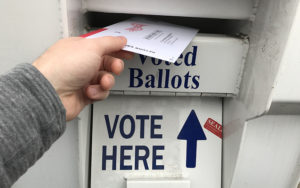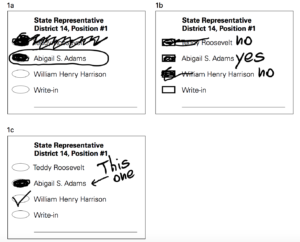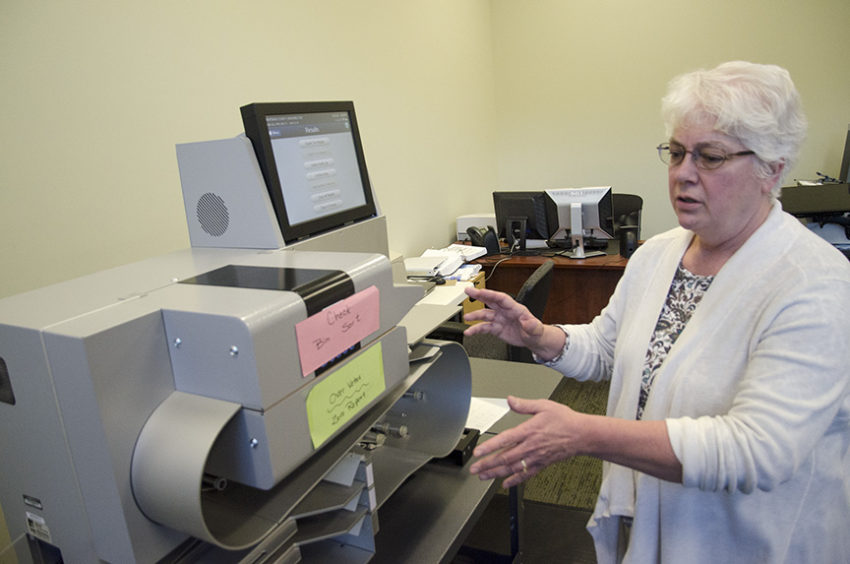Here’s what your Whitman County ballot will be up to today as you sit waiting for preliminary results to come in this evening. Last month, I stopped by for a tour of the county Elections Center and a chat with Auditor Eunice Coker about how officials handle and process ballots.
It’s a somewhat complicated process by design — to protect voter anonymity while also maintaining a strict account of each ballot. Here’s a behind-the-scenes look:
What you get to vote on in the first place
Whitman County has a complex Venn diagram of overlapping legislative, county and taxing districts designating what ends up on your ballot. Auditor Eunice Coker said these “levy code splits” create dozens of unique ballot templates to match the issues different voters get to weigh in on based on residency.
In addition to state and county races, she said there are 16 cities and towns, eight cemeteries, at least seven park and rec districts, 14 school districts, 13 fire districts, hospital districts and the library district.
“There’s 170-something levy code splits,” she said. “I think we have more than any county in the state.”
Many other counties consolidate those districts, she said. Spokane has a single school district covering most of the county. Whitman County has more than a dozen, all with separate superintendents and school boards.
To help explain, she drew a number of stacked circles on a sketch of the county, representing dozens of pockets of distinct voting layers.
She squinted at the drawing: “Looks like a sick turtle.”
How your ballots gets to Elections Center
If you haven’t mailed your ballot by now, you should really find a local drop box or ballot center. Like, really. Whitman County mail gets processed through the postal center in Spokane and mailing today could result in missing the 5 p.m. postmark deadline. You can still check out our Voters Guide.
Coker said ballots postmarked late will absolutely not get counted.

So you either mailed your ballot early. Free of postage this time. Or you found one of the five drop-off locations in the county. Coker said unstaffed boxes get cleared every three or four days. Election officials must handle ballots in pairs and the boxes get sealed with tape to prevent tampering.
You have until 8 p.m. tonight to get your ballot in one of those boxes. Then they get locked for good.
Coker and her husband will drive around and empty many of the drop boxes. They use zippered bags on rollers similar to heavy-duty bank-style cash bags, she said. They will check and replace seals on the drop boxes and lock the ballots in the back of their truck for transport.
Those ballots will be combined with the mail-in ballots for initial processing.
How your ballot gets processed for ID confirmation
Election officials have spent the past several weeks confirming new registrations and transfers from other counties. Coker said her office has seen a dramatic increase in registrations, including more than 2,000 from WSU voter drives that may have violated guidelines for handling registrations. Her office has processed most of those registration as it would any others.
“In this particular election, the issue we’re having is a happy issue that’s causing problems,” she said. “Only because we’re so short staffed.”
Election staffers run those new registrations through a statewide database to check for duplicate registrations, deaths, felony convictions or other disqualifying issues. The staff will also compare voter registrations to driver’s license records and signatures on file to assess each voter’s identity.
Staffers will first separate ballots into a batch of 150 to 200 ballots, Coker said. Those distinct batches get logged and tracked together throughout the tabulation process. Within each batch, officials will make an initial sort based on the ballot signature.
Coker said election staffers get trained in handwriting and signature recognition by the Secret Service and the Washington State Patrol. (“We do know what we’re doing.”) They will pull up a database of the voter’s existing signatures on file to compare each ballot.
“So you come across one that really doesn’t match,” she said. “Ninety-five percent of the time it’s not forgery. They just scribbled.”
But ballots with missing or mismatched signatures get pulled from the batch for follow-up confirmation. The rest of the batch goes on to the letter-opening machine. Once opened, Coker said, staffers will turn envelopes names away and pull out the privacy envelopes from inside the mailing envelope.
After the mailing envelope is emptied, staffers run a string through the little holes to make sure they’re clear and the envelopes go into locked storage.
How it gets sorted for scanning and tabulation
Now election workers are handling just the anonymous ballot forms with specific votes. Staffers will again sort through each batch to check for damage or irregularities, such as someone crossing out a bubble or marking votes in ways the tabulating machine cannot read.
“We’re looking to see if there are any over-votes, write-ins, rips, tears, crayon,” Coker said. “This very fancy, expensive, top-of-the-line machine right here — I like to say that because Colfax doesn’t usually have top of the line — won’t read crayon.”
Whitman County uses the state’s Voter Intent Manual to interpret how to count votes that didn’t follow the standard instructions. As long as the voter indicated his or her choices consistently, Coker said the staff usually feels confident counting those votes.

Ballots with irregularities get set aside so a staffer can copy their choices over to a fresh ballot sheet, so it can be counted with the rest of the ballots through the tabulator. Coker said that duplication process can “freak” some people out, but all copies get logged within the batch.
To help safeguard the integrity of the process, election observers from both political parties can watch throughout the process. Coker expects those observers to be paying particularly close attention this year considering the slate of contentious races. Media are also expected to observe.
“(And) anytime there’s ballots being worked on in the room, there has to be two people,” she said, adding, “All of these have logs and seals at the end of the day that get locked away.”
At this point in the process all batches, with any necessary duplication ballots, should be ready to scan into the tabulation machine.
“What’s left there,” Coker said, “we’re almost 100 percent positive it’s going to fly through this scanner. … They’re now waiting for Election Day.”
How you vote actually gets counted
Staffers started scanning those pre-screened ballots into the tabulation machine this morning. Coker said they will likely spend several hours loading batches through the machine — an ES&S DS850. Any ballots that don’t read properly get kicked out for a manual check. The machine also logs those. Her office cannot tell the machine to actually count the ballots until polls close at 8 p.m.
Prior to scanning, officials zero out the machine and make sure it reads all ballot templates properly, Coker said. The Secretary of State sent a representative to check the machine back on Oct. 10 for a Logic and Accuracy test. Whitman County’s machine passed that test, she said, and a certificate is also locked away on file.
So once all of the prepared ballots get scanned, the staff will wait until polls close.
“When we push the button at 8 o’clock on election night,” she said, “that’s when the votes tabulate.”
The tabulation machine will record the results on to thumb drives, Coker said. Officials take that drive to a laptop station that is only connected to electricity and a printer.
“There’s no wifi. There’s no internet,” she said. “It’s just a glorified typewriter, I guess.”
That printout represents the official election results. Coker said her staff will immediately load those preliminary results to the Secretary of State website. They will then close up the office and prepare for processing the thousands of ballots that will likely trickle in over the next few days.
“We have to tabulate every three days,” she said.
What happens next?
Election staff will go out Wednesday morning to collect the last of the drop-box ballots and they will process those alongside the incoming mail ballots in preparation for the second official tabulation on Friday. Coker said voters whose ballots had signature or identification issues will receive a letter and usually a phone call asking them to “cure” their ballots by providing additional confirmation.
Ballots that get cured will go back into the tabulation schedule. Coker recommends responding to those letters or calls as soon as possible.
Any unconfirmed ballots or other election issues will go before the county Canvassing Board at 9 a.m. on Nov. 26 in a public meeting at the Elections Center. The Canvassing Board consists of the auditor, the county prosecutor and the chair of the board of county commissioners.
Coker said the board will review any questionable ballots and sign off on any final rejections or approvals. Ballots approved by the board will get tabulated for the final certified results on Nov. 27.
“We just want the numbers to come out at the end,” Coker said. “Whoever wins, may they win large, so there’s no recount.”
